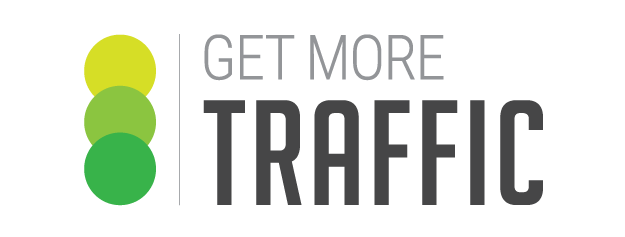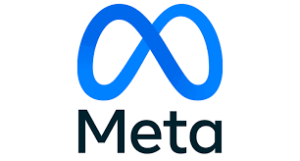What is Meta?
Meta, is a company that has redefined the way we connect, communicate, and consume content. Meta, previously known as Facebook, has expanded its horizons beyond the conventional realms of social networking and now offers a multitude of services under its umbrella. One of the standout components of this transformation is Meta Ads – a dynamic advertising platform that enables businesses to engage with their target audience like never before. Its flagship product, the Facebook social media platform, has grown to encompass a broader vision, leading to the rebranding of the company as Meta. Meta envisions a metaverse that goes beyond traditional digital experiences, integrating augmented reality, virtual reality, and various other technological advancements.
What are Meta Ads?
Definition
Meta Ads, an integral part of Meta’s ecosystem, are a sophisticated form of digital marketing that empowers businesses to connect with their target audience across multiple platforms, including Facebook, Instagram, Messenger, and more. These ads leverage the vast amount of data within the Meta network to deliver personalized and relevant content to users, thereby enhancing the effectiveness of marketing campaigns.
Purpose
Meta Ads serve a multifaceted purpose in the digital marketing landscape. They enable businesses to reach a wider audience by connecting people from all over the world as their potential target audience. It provides a diverse range of advertising formats like video or image which caters to various business goals and creative strategies which maximises engagement. It also helps with analysing results as it provides tools and techniques to track the performance of the campaigns in real-time, enabling data-driven optimizations.
Types of Meta Ads
Facebook Ads

They let businesses use single images to promote their products, services, or brand. Image ads can be used across different ad types, placements, and aspect ratios. Image ads are a good fit for campaigns with strong visual content that can be shown in just one image. These images could be made from illustrations, design, or photography.
Facebook lets businesses use a single video to showcase their products, services, or brand.They’re especially helpful for product demos, tutorials, and showcasing moving elements.
Carousel ads showcase up to ten images or videos that users can click through. Each has its own headline, description, or link. Carousels are a great choice for displaying a series of different products. Each image in the carousel can even have its own landing page that’s specifically built for that product or service.
Instant Experience ads, previously known as Canvas Ads, are mobile-only interactive ads that let users engage with your promoted content on Facebook. Using Instant Experience ads, users can tap through a carousel display of images, shift the screen in different directions, as well as zoom in or out of content.
Collection ads are kind of like immersive carousels — taking the user experience a step up. Collection ads are mobile window-shopping experiences where users can flick through your product lineup.
Instagram Ads
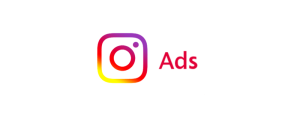
These are single-image ads that appear in users’ Instagram feeds. They are a simple yet effective way to showcase products or services and can be used to drive traffic to a website or landing page.
Video ads are similar to photo ads, but they use videos instead of images to convey the message. Instagram videos can be up to 60 minutes long, but you should prefer much shorter videos for your ad. Video ads are a great way to tell a brand story or showcase a product in action.
-
Carousel ads
Carousel ads allow businesses to showcase multiple images or videos within a single ad unit. Users can swipe through the images or videos, giving them a more immersive experience.
-
Story ads
Instagram Stories ads are full-screen ads that appear in between users’ stories. These ads are a great way to create interactive and immersive experiences for users and this is why engagement is often higher with this type of ad.
-
Collection ads
Collection ads are designed for e-commerce businesses and allow users to shop directly from within the ad. These ads feature a cover image or video and multiple product images below, making it easy for users to browse and purchase products.
-
Explore ads
Explore ads appear in the Explore section of the Instagram app, where users discover new content. These ads are a great way to reach a new audience and increase brand awareness. Instagram Explore ads do not appear directly in the Explore section, but are shown after someone clicks on a photo or video from Explore.
-
Shopping ads
Designed for e-commerce businesses that have a shop on Instagram, Shopping ads take users directly to a product description page within the app. From there, your customers can easily make a purchase.
-
Reels ads
After the launch of Reels, Instagram has also allowed Reels Ads. These ads are usually videos, up to 60 seconds long, that are shown between Reels.
Process
Step 1. Choose your objective
Login into Facebook Ads Manager and select the Campaign tab, then click Create to get started with a new Facebook ad campaign. There are 3 marketing categories – Awareness, Consideration and Conversion that Facebook provides with consumers on what they want their ad to accomplish.
Step 2. Name your campaign
Name your Facebook ad campaign and declare whether your ad fits into any special categories like credit or politics. If you want to set up an A/B split test, click Get Started in the A/B Test section to set this ad as your control. You can choose different versions to run against this ad after it’s published. Scroll down a little further to choose whether to turn on Advantage Campaign Budget+. This option can be useful if you’re using multiple ad sets, but for now, you can leave it turned off. Click Next.
Step 3. Set your budget and schedule
At the top of this screen, you will name your ad set and choose which Page to promote. Next, you decide how much money you want to spend on your Facebook ad campaign. You can choose a daily or lifetime budget. Then, set the start and end dates if you want to schedule your ad in the future or choose to make it live right away.
Step 4. Target your audience
Scroll down to start building the target audience for your ads. Start by selecting your target location, age, gender and language. Under location, you can even choose to include or exclude cities over a certain size. You can also prioritize people who’ve recently shown an interest in the product or service you sell.
Step 5. Choose your Facebook Placements
Scroll down to choose where your ads will appear. If you’re new to Facebook advertising, the simplest choice is to use Advantage+ Placements. When you select this option, Facebook will automatically place your ads across Facebook, Instagram, Messenger, and the Audience Network when they are likely to get the best results
Step 6. Set brand safety and cost controls
Scroll down to the Brand Safety section to exclude any types of content that would be inappropriate to appear with your ad.
Step 7. Create your ad
First, choose your ad format, then enter the text and media components for your ad. The formats available will vary based on the campaign objective you selected back at the beginning of this process. Use the preview tool at the right of the page to make sure your ad looks good for all potential placements. When you’re happy with your choices, click the green Publish button to launch your ad.
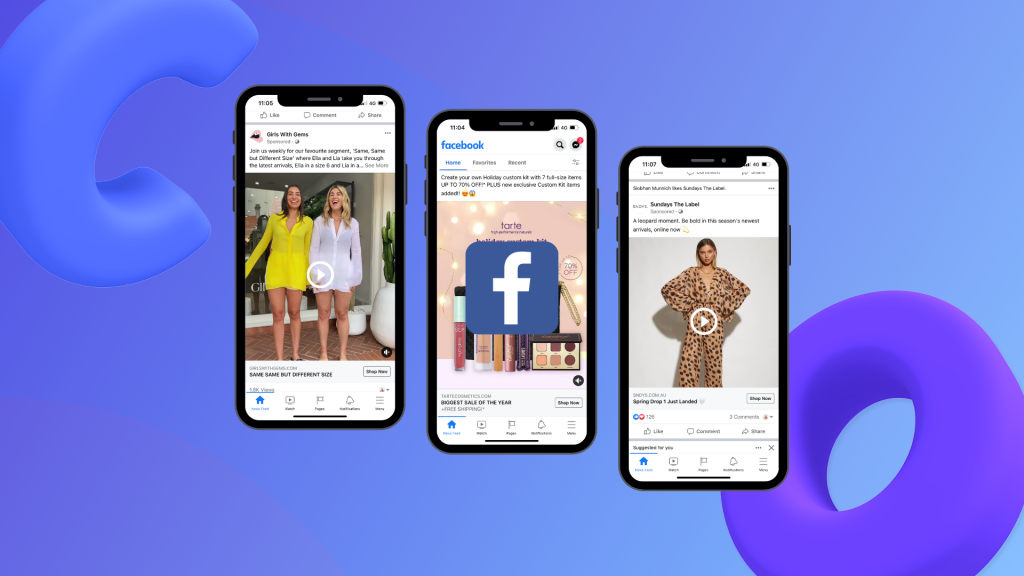
Tips and Tricks
- Use vertical videos: Use a vertical or square aspect ratio. Most people hold their phones vertically, so you’ll cover more of their screen.
- Shorten text: People on Facebook and Instagram scan quickly. In research conducted by the Mobile Marketing Association, it took two to three seconds for two out of three for people to see and cognitively recognise desktop ads compared to 0.4 seconds on mobile. Keep your text short, clear and concise to get your message across.
- Add multiple images using the carousel format: Carousel allows you to show several images for people to scroll through at the same cost. It’s a great opportunity if you have lots of product or brand images.
- Add movement: Ads with movement can stand out in Feed. Templates in Meta Ads Manager can help you create a video ad from your images.
- Use calls to action: A range of call-to-action (CTA) buttons are available for Facebook and Instagram ads. These buttons draw attention and encourage people to engage with your ad. Based on what you want people to do when they see your ad, experiment with the CTA buttons available for different ad objectives and formats. See which ones get your audience to take action.
Resources
Paid Meta Training Resources
Free Meta Training Resources
YouTube is not only a platform for sharing videos but also a powerful advertising tool that allows businesses to reach a global audience in creative and engaging ways. Understanding the various YouTube ad formats is crucial for creating successful ad campaigns that resonate with your target audience. In this comprehensive guide, we will explore the different YouTube ad formats, their features, benefits, and when to use each format effectively.

Exploring the differences of YouTube Ad Formats:
Skippable Ads
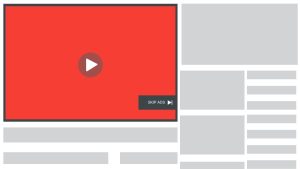
Best for: Maximizing Brand Exposure
Skippable ads, also known as TrueView in-stream ads, are one of the most common ad formats on YouTube. These ads appear before, during, or after a user’s chosen video and can be skipped after the first 5 seconds. The key features include:
- Ad Length: Skippable ads can vary in length, but the first 5 seconds are crucial for capturing viewers’ attention
- Engagement: Viewers can skip the ad after 5 seconds, so creating a compelling hook in the beginning is essential
- Cost: Advertisers are charged when viewers watch at least 30 seconds of the ad of the entire ad if it’s shorter than 30 seconds
Non- Skippable Ads
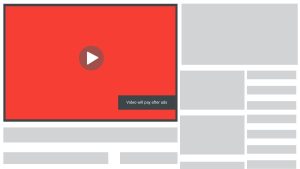
Best for: Conveying Important Messages
Non-skippable ads are short video ads that viewers are required to watch before they can access their chosen video content. These ads are limited to 15 seconds in most cases. Key features include:
- Viewing Obligation: Viewers must watch the entire ad, which can lead to higher engagement
- Message Efficiency: Due to the time constraint, these ads require clear and concise messaging
- User Experience: While they ensure ad views, non-skippable ads can be seen as intrusive if not well-crafted
Bumper Ads

Best for: Delivering A Punchy Message
Bumper ads are short, non-skippable video ads that are limited to 6 seconds. These ads are designed to be concise and impactful, making them ideal for mobile users. Key features include:
- Limited Length: The 6-second limit encourages advertisers to convey their message quickly and creatively
- Mobile-Friendly: Bumper ads are effective on mobile devices, where attention spans are typically shorter
- Frequency: They can be used as a supplement to longer ads to reinforce your message
Overlay Ads

Best for: Prompting a call to action (CTA)
Overlay ads, also known as display ads, appear as banner ads at the bottom of the video player. They can be text-based or rich media ads. Key features include:
- Visual Presence: Overlay ads don’t interrupt the video content and are displayed as a semi-transparent overlay
- Engagement: They encourage viewers to click through to your website or landing page
- CTR Tracking: Overlay ads’ click-through rates (CTR) can help measure their effectiveness
Sponsored Cards
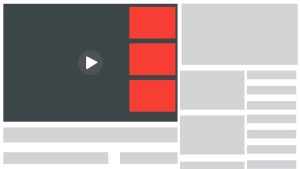
Best for: Showcasing products
Sponsored cards are interactive, content-specific cards that promote products featured within the video or related products. They appear as small teasers within the video. Key features include:
- Contextual: Sponsored cards provide relevant information about the products or services featured in the video
- Interactivity: Viewers can click on the card to see mobile details or visit the advertiser’s website
- Engagement: These cards enhance the user experience by offering additional value
Discovery Ads

Best for: Capturing Intentful Viewers
Discovery ads, previously known ad TrueView discovery ads, are promoted videos that appear in YouTube search results, alongside related videos, and on the YouTube mobile homepage: Key features include:
- Placement: Discovery ads are strategically placed in areas where users are actively looking for content
- Viewer Intent: These ads target users who are more likely to engage due to their search or browsing behaviour
- Thumbnail and Title: The ad’s success depends on an attention-grabbing thumbnail and an enticing title
Masthead Ads

Best for: Broad Audience Impact
Masthead Ads, also known as YouTube’s “Masthead” placement, allow your video to take center stage at the top of YouTube’s homepage on all devices, from desktops to mobile devices and smart TVs. The prime real estate grants you unparalleled visibility and exposure, making it an ideal choice for campaigns aimed at maximum reach and brand impact. Key features include:
- Massive Reach: Engaging a diverse audience with prime placement, ensure that your message reaches users across various demographics and interests
- Visual impact: Capture attention instantly with autoplay visuals
- Clickable CTAs: Direct traffic with overlay CTSs for seamless engagement
10 Steps to Start YouTube Ads

Starting YouTube ads involves careful planning and execution, but the potential to reach a massive and engaged audience makes it worthwhile. By following these 10 steps, you will be on your way to create impactful and successful YouTube ad campaigns that drive your marketing objectives.
1.Define Goals:
Clarify your campaign objectives. Are you aiming for brand exposure, website traffic, lead generation, or sales conversions? Having clear goals will shape your entire strategy
2. Create Channel:
Establish a YouTube channel for your business. This provides a dedicated space to host your video content and manage your advertising campaigns
3. Link Accounts:
Link your YouTube channel to a Google Ads account. This integration allows you to manage and track your ad campaign seamlessly
4. Budget:
Determine your budget for the campaign. Decide whether you want to allocate a specific amount per data or for the entire campaign duration. Google Ads offers various budgeting options to suit your needs.’
5. Audience:
Identifying your target audience. Consider demographics like age, gender, location, and interests. The more precise your audience targeting, the higher the chances of reaching the right viewers
6. Choose Format:
Select the appropriate ad format based on your goals. For instance, if you want to create brand awareness, skippable ads might be ideal. If you have a short, impactful message, bumper ads could work better
7. Craft Content:
Develop compelling video content that resonates with your audience. Start with a captivating hook in the opening seconds to capture viewers’ attention and encourage them to watch further
8. Set tracking:
Implement tracking mechanisms, such as Google Analytics or conversion tracking, to measure the effectiveness of your campaign. This data helps you refine your strategy and understand what’s working
9. Campaign Details:
Configure campaign parameters. Specify the campaign start and end dates, ad scheduling (when your ads will run), and geographic targeting (where your ads will be shown)
10. Launch and Optimize:
Review your campaign settings, content, and targeting one final time. Once you are satisfied, launch the campaign. Continuously monitor key performance indicators (KPIs) like click-through rates, view rates, and conversions. Use these insights to optimize your ads for better results over time
As you navigate the world of YouTube advertising, understanding these various ad formats is essential for tailoring your campaigns to your audience’s preferences and behavious. Each format offers unique advantages, and by strategically using them, you can create compelling and experiences that resonate with viewers and drive your marketing goals.
The key to a successful YouTube ad campaign is not only choosing the right format but also crafting engaging content that captures your audience’s attention and encourages them to take action.
Boost Your Business: 10 Quick Social Media Tips for Tradies
Quick Social Media Tips for Tradies
In this modern world, social media has become more than just a way to connect; it’s a powerful tool that can transform businesses and careers. For tradies, harnessing the potential of social media marketing is a game-changer. It means to showcase their craftsmanship, engage with clients, and take their businesses to the next level.
Platforms like Facebook, Instagram, and LinkedIn offer tradies the chance to amplify their skills, tell their stories, and reach a wider audience than ever before. With every post, image, and interaction, tradies can build a brand that stands out and creates lasting impressions.
This guide delves into the essentials of social media marketing for tradies. From choosing the right platforms to crafting compelling content, we’ll navigate the landscape together. Whether you are a seasoned pro looking to expand your reach or a newcomer ready to make a mart, this guide is your roadmap to leveraging social media for your tradie business.
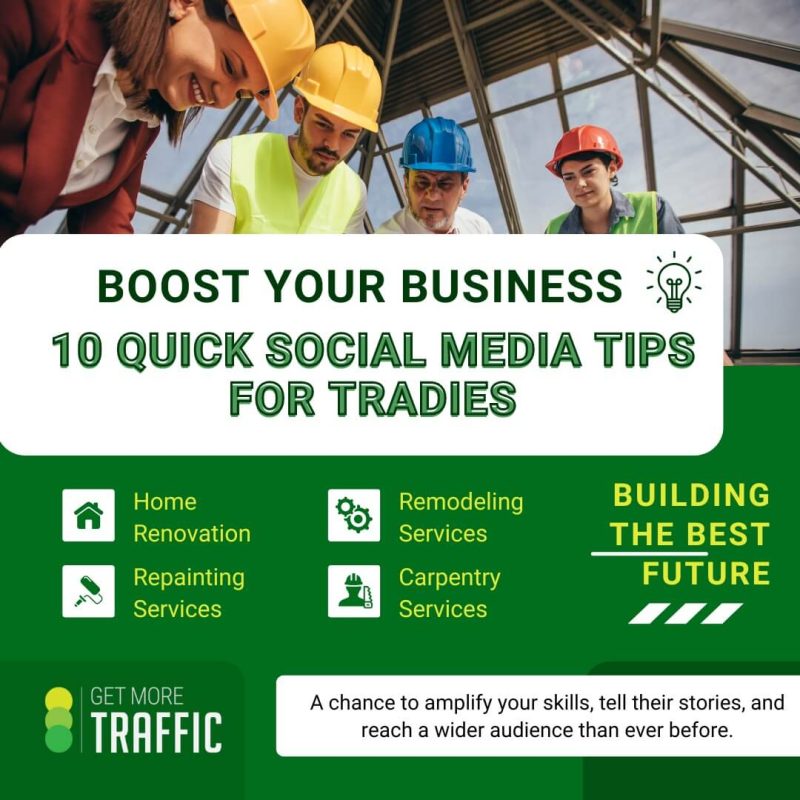
1. Choose the Right Platforms
Focus on platforms that align with your target audience. Selecting the most suitable platforms is a critical step. Not all platforms are created equal, and different platforms attract different demographics and user behaviours. The choice of platforms should align with your target audience and the nature of your trade. Facebook, Instagram, and LinkedIn are popular choices. Instagram is great for visual content, while LinkedIn can be useful for connecting with other professionals and businesses.
2. Optimise Your Profiles
Optimising your profiles is a crucial step in making a strong first impression and establishing credibility on social media platforms. Ensure your profiles are complete, consistent, and professional. Use high-quality profile and cover images, and write a clear and concise bio that highlights your services and expertise. Your platforms serve as the digital storefront for your tradie business, and they should reflect professionalism, expertise, and a clear representation of your services. Some key elements to be focused on include:
- Profile and Cover Images
- Bio and About Section
- Contact information
- Visual elements
- Call to Action (CTA)
4. Showcase Your Work

Visual content is a powerful tool especially for tradies to demonstrate their expertise, creativity, and the transformative impact of their work. When potential clients can see the tangible results you can deliver, it builds trust and excitement. Here is how you can effectively showcase your work:
- Before-and-After Stories:
- Visual transformation: Capture the dramatic change your work brings by posting before-and-after photos. The visual storytelling provides a clear and compelling narrative of your skills
- High-Quality Imagery:
- Attention to Detail: Ensure that the images you share are of high quality, well-lit, and showcase the finer details of your work. Crisp visuals reflect professionalism and attention to detail
- Project Progress Updates:
- Step-by-Step Journey: Use platforms like Instagram to share the progression of your projects. Carousel posts allow you to showcase a series of images, demonstrating the various stages of your work
- Project Descriptions:
- Highlight Key Details: Alongside your images, provide brief descriptions of the projects. Include information like project type, materials used, and any unique aspects that set it apart
- Client testimonials:
- Social Proof: Share testimonials from satisfied clients alongside images of their projects. This combination of visuals and positive feedback strengthens your credibility
4. Engage Authentically
Engaging with your audience authentically is a cornerstone of effective social media marketing. It is not just about broadcasting your message; it is about building relationships, nurturing connections, and establishing your brand as approachable and reliable. By engaging authentically, you foster a sense of connection and community, transforming casual viewers into dedicated followers and potential clients into loyal customers. Genuine interactions leave a lasting impression, contributing to the growth and success of your tradie business.
5. Use Relevant Hashtags
Research and use industry-related and location-specific hashtags to increase the visibility of your posts. Hashtags are like signposts that help users discover content related to specific topics or themes. For tradies, using relevant hashtags strategically can significantly boost the visibility of your posts and attract the attention of potential clients who are searching for services in your industry. Hashtags that are relevant to you include:
- Trending Hashtags – keep an eye on trending hashtags related to your trade
- Platform-Specific Tags – Utilize platform features
- A Branded Hashtag – create a unique hashtag that represents your business
- Local Discovery – Connect with your local community, build a reputation as a trusted trade in your area
6. Educational Content
Educational content is a valuable way to position yourself as an expert in your field and provide real value to your audience. Share informative content related to your field. By sharing tips, how-to guides, and industry insights, you not only demonstrate your expertise but also foster a sense of trust and credibility. Here is how you can effectively create and share educational content:
- Identify Your Audience’s Needs:
- Understand Pain Points and consider the common challenges, questions, and concerns that your clients and potential clients have
- Clear and Concise Content:
- Simplify Complex Concepts by breaking down complex ideas into simple and understandable terms. Use clear language and step-by-step explanations
- Step-by-Step Guides:
- Crafting step-by-step guides for common DIY tasks or maintenance routines
- Industry Insights:
- Stay current and share updates about industry trends, innovations, and news
- Address FAQs:
- Compile a list of frequently asked questions from clients and address them in your content to help preempt doubts and provides quick solutions
7. Customer Testimonials
To build trust and credibility, customer testimonials are a powerful form of social proof that can significantly influence potential clients’ perceptions of your tradie business. By showcasing genuine customer testimonials, you can build a narrative of satisfied clients who have benefited from your services. This form of social proof can be a decisive factor for potential clients considering whether to choose your tradie business.
8. Behind-the-Scenes Content

Behind-the-scenes content humanized your brand, offering a glimpse into the people, processes, and stories that drive your tradie business. It adds a personal touch to your online presence, fostering a sense of connection and relatability with your audience. Some behind-the-scenes content include documenting day-to-day activities, highlighting team members, project evolution, problem-solving moments, introducing tools and techniques, showcase craftsmanship, and celebrations and milestones and more.
9. Analytics and Insights
Analytics and insights are valuable tools that provide you with data-driven insights into how your content is performing on social media platforms. By understanding what’s working and what’s not, you can make informed decisions to optimize your strategy for better results. Use the built-in analytics tools on each platform to track the performance of your posts and campaigns. You are able to tailor your content, posting schedule, and overall strategy to match your audience’s preferences and behaviors. Regularly monitoring and analyzing your analytics empowers you to make data-driven decisions that yield more effective results over time.
10. Paid Advertising
Paid advertising on social media offers a powerful way to expand your reach, target specific demographics, and promote your tradie services to a larger audience. Platforms like Facebook, Instagram, and others provide sophisticated tools for precise ad targeting, making your campaigns more effective.It also allows you to tap into the platforms’ extensive user base and finely tune your campaigns to reach the right people at the right time. It is a dynamic tool that can yield impressive results and contribute to the growth of your tradie business.

In conclusion, social media marketing presents a remarkable opportunity for tradies to amplify their businesses, connect with potential clients and establish themselves as trusted experts in their fields. By implementing these strategies, tradies can cultivate a strong online presence, connect with their desired audience, and ultimately drive business growth.
Boost Your Business: 10 Quick Social Media Tips for Tradies
Quick Social Media Tips for Tradies
In this modern world, social media has become more than just a way to connect; it’s a powerful tool that can transform businesses and careers. For tradies, harnessing the potential of social media marketing is a game-changer. It means to showcase their craftsmanship, engage with clients, and take their businesses to the next level.
Platforms like Facebook, Instagram, and LinkedIn offer tradies the chance to amplify their skills, tell their stories, and reach a wider audience than ever before. With every post, image, and interaction, tradies can build a brand that stands out and creates lasting impressions.
This guide delves into the essentials of social media marketing for tradies. From choosing the right platforms to crafting compelling content, we’ll navigate the landscape together. Whether you are a seasoned pro looking to expand your reach or a newcomer ready to make a mart, this guide is your roadmap to leveraging social media for your tradie business.

1. Choose the Right Platforms
Focus on platforms that align with your target audience. Selecting the most suitable platforms is a critical step. Not all platforms are created equal, and different platforms attract different demographics and user behaviours. The choice of platforms should align with your target audience and the nature of your trade. Facebook, Instagram, and LinkedIn are popular choices. Instagram is great for visual content, while LinkedIn can be useful for connecting with other professionals and businesses.
2. Optimise Your Profiles
Optimising your profiles is a crucial step in making a strong first impression and establishing credibility on social media platforms. Ensure your profiles are complete, consistent, and professional. Use high-quality profile and cover images, and write a clear and concise bio that highlights your services and expertise. Your platforms serve as the digital storefront for your tradie business, and they should reflect professionalism, expertise, and a clear representation of your services. Some key elements to be focused on include:
- Profile and Cover Images
- Bio and About Section
- Contact information
- Visual elements
- Call to Action (CTA)
4. Showcase Your Work

Visual content is a powerful tool especially for tradies to demonstrate their expertise, creativity, and the transformative impact of their work. When potential clients can see the tangible results you can deliver, it builds trust and excitement. Here is how you can effectively showcase your work:
- Before-and-After Stories:
- Visual transformation: Capture the dramatic change your work brings by posting before-and-after photos. The visual storytelling provides a clear and compelling narrative of your skills
- High-Quality Imagery:
- Attention to Detail: Ensure that the images you share are of high quality, well-lit, and showcase the finer details of your work. Crisp visuals reflect professionalism and attention to detail
- Project Progress Updates:
- Step-by-Step Journey: Use platforms like Instagram to share the progression of your projects. Carousel posts allow you to showcase a series of images, demonstrating the various stages of your work
- Project Descriptions:
- Highlight Key Details: Alongside your images, provide brief descriptions of the projects. Include information like project type, materials used, and any unique aspects that set it apart
- Client testimonials:
- Social Proof: Share testimonials from satisfied clients alongside images of their projects. This combination of visuals and positive feedback strengthens your credibility
4. Engage Authentically
Engaging with your audience authentically is a cornerstone of effective social media marketing. It is not just about broadcasting your message; it is about building relationships, nurturing connections, and establishing your brand as approachable and reliable. By engaging authentically, you foster a sense of connection and community, transforming casual viewers into dedicated followers and potential clients into loyal customers. Genuine interactions leave a lasting impression, contributing to the growth and success of your tradie business.
5. Use Relevant Hashtags
Research and use industry-related and location-specific hashtags to increase the visibility of your posts. Hashtags are like signposts that help users discover content related to specific topics or themes. For tradies, using relevant hashtags strategically can significantly boost the visibility of your posts and attract the attention of potential clients who are searching for services in your industry. Hashtags that are relevant to you include:
- Trending Hashtags – keep an eye on trending hashtags related to your trade
- Platform-Specific Tags – Utilize platform features
- A Branded Hashtag – create a unique hashtag that represents your business
- Local Discovery – Connect with your local community, build a reputation as a trusted trade in your area
6. Educational Content
Educational content is a valuable way to position yourself as an expert in your field and provide real value to your audience. Share informative content related to your field. By sharing tips, how-to guides, and industry insights, you not only demonstrate your expertise but also foster a sense of trust and credibility. Here is how you can effectively create and share educational content:
- Identify Your Audience’s Needs:
- Understand Pain Points and consider the common challenges, questions, and concerns that your clients and potential clients have
- Clear and Concise Content:
- Simplify Complex Concepts by breaking down complex ideas into simple and understandable terms. Use clear language and step-by-step explanations
- Step-by-Step Guides:
- Crafting step-by-step guides for common DIY tasks or maintenance routines
- Industry Insights:
- Stay current and share updates about industry trends, innovations, and news
- Address FAQs:
- Compile a list of frequently asked questions from clients and address them in your content to help preempt doubts and provides quick solutions
7. Customer Testimonials
To build trust and credibility, customer testimonials are a powerful form of social proof that can significantly influence potential clients’ perceptions of your tradie business. By showcasing genuine customer testimonials, you can build a narrative of satisfied clients who have benefited from your services. This form of social proof can be a decisive factor for potential clients considering whether to choose your tradie business.
8. Behind-the-Scenes Content

Behind-the-scenes content humanized your brand, offering a glimpse into the people, processes, and stories that drive your tradie business. It adds a personal touch to your online presence, fostering a sense of connection and relatability with your audience. Some behind-the-scenes content include documenting day-to-day activities, highlighting team members, project evolution, problem-solving moments, introducing tools and techniques, showcase craftsmanship, and celebrations and milestones and more.
9. Analytics and Insights
Analytics and insights are valuable tools that provide you with data-driven insights into how your content is performing on social media platforms. By understanding what’s working and what’s not, you can make informed decisions to optimize your strategy for better results. Use the built-in analytics tools on each platform to track the performance of your posts and campaigns. You are able to tailor your content, posting schedule, and overall strategy to match your audience’s preferences and behaviors. Regularly monitoring and analyzing your analytics empowers you to make data-driven decisions that yield more effective results over time.
10. Paid Advertising
Paid advertising on social media offers a powerful way to expand your reach, target specific demographics, and promote your tradie services to a larger audience. Platforms like Facebook, Instagram, and others provide sophisticated tools for precise ad targeting, making your campaigns more effective.It also allows you to tap into the platforms’ extensive user base and finely tune your campaigns to reach the right people at the right time. It is a dynamic tool that can yield impressive results and contribute to the growth of your tradie business.

In conclusion, social media marketing presents a remarkable opportunity for tradies to amplify their businesses, connect with potential clients and establish themselves as trusted experts in their fields. By implementing these strategies, tradies can cultivate a strong online presence, connect with their desired audience, and ultimately drive business growth.
Instagram vs. TikTok: Which Platform Is Right for Your Brand?
Social media has become an integral part of any brand’s marketing strategy, and Instagram and TikTok have emerged as two major players in the social media landscape. Both platforms offer unique opportunities to connect with audiences and promote products or services. However, choosing the right platform for your brand requires understanding their differences, target demographics, and content formats.
In this article, we will compare Instagram and TikTok, helping you make an informed decision on which platform aligns best with your brand’s marketing goals.
1. User Demographics:
User demographics refer to the characteristics and traits of a specific group of individuals who use a particular product, service, or platform. In the context of social media marketing, user demographics include factors such as age, gender, location, education level, income, interests, and behaviors. Understanding user demographics is crucial for businesses and marketers to tailor their marketing strategies and content to better reach and engage their target audience. Understand Instagram and TikTok’s audience and niche communities below:
Instagram User Demographics
- Age:
- Particularly among younger users, especially those aged between 18 and 34 years old, with an increasing number of users aged 35 and above
- Gender:
- Slightly higher percentage of female users
- Interests: Often interested in fashion, travel, food, lifestyle, fitness and photography
TikTok User Demographics
- Age:
- Majority of users falling between the ages of 16 and 24
- Reach Gen Z and younger Millennial consumers
- Gender:
- Relatively balanced gender distribution, attracting both male and female users
- Interests:
- Creatine and entertaining content, including dance challenges, lip-syncing, comedy skits, and educational videos
2. Content Formats:
In social media marketing, content formatting refers to the process of structuring and presenting content in a way that optimizes its visual appeal, readability, and engagement on social media platforms. Effective content formatting enhances the chances of capturing the audience’s attention, conveying the intended message, and encouraging them to take action. Proper content formatting is essential because social media platforms have limited space and user attention spans, making it crucial to make content visually appealing and easy to consume. Here are some key aspects of content formatting in social media marketing between Instagram and TikTok:
Instagram Content Formats:
- Photo-sharing platform, and images are a fundamental content format
- Showcase products, behind-the-scenes glimpses, lifestyle shots, and visually appealing content to capture users’ attention
- Various video lengths, ranging from short stories (15 seconds) to regular posts (up to 1 minute) and IGTV (longer-form videos up to 15 minutes)
- Use Stories to share time-sensitive content, behind-the-scenes footage, polls, Q&A sessions, and interactive stickers like quizzes and countdowns
- Carousels posts allow brands to share multiple images or videos in a single post, which users can swipe through
TikTok Content Formats:
- Primary content format consists of short videos, often set to music or audio clips
- Create entertaining, informative, or humorous videos to showcase products, share tips, participate in challenges, and engage with their audience
- Allows users to interact with content using duets and stitches to create videos alongside existing content, fostering collaboration and interaction
- Known for viral trends and challenges
- Seek educational content, such as DIY tutorials, cooking recipes, and life hacks
- Use live streaming for Q&A sessions, product launches, behind-the-scenes moments, and interactive events
3. Engagement and Reach:
Engagement refers to the level of interaction and interaction your content receives from your audience. It encompasses actions such as likes, comments, shares, saves, and clicks on your posts. High engagement indicates that your content is compelling, relevant, and valuable to your followers. It also signals to social media algorithms that your content is worth promoting, which can boost its visibility and reach.
Reach refers to the number of unique users who see your content. It is an essential metric as it measures the potential size of your audience. A higher reach means your content is being seen by more people, increasing brand visibility and awareness. Reach can be organic, where users discover your content through their feeds, or paid, through social media advertising.
To Improve Engagement:
- Create Compelling Content: Craft visually appealing, informative, and entertaining content that aligns with your audience’s interests and preferences.
- Encourage Interactivity: Use engaging captions and ask questions to prompt discussions. Encourage followers to share their opinions and experiences.
- Respond to Comments: Engage with your audience by responding to comments and messages promptly. Building a two-way conversation fosters a sense of community.
- Host Giveaways and Contests: Organize giveaways and contests to incentivize audience participation and increase engagement.
- Leverage User-Generated Content (UGC): Encourage your followers to create and share content related to your brand, showcasing their positive experiences.
To Improve Reach:
- Use Relevant Hashtags: Research and include relevant hashtags in your posts to improve discoverability and reach a broader audience.
- Optimize Posting Times: Determine the best times to post based on your audience’s active hours to ensure your content reaches more users.
- Collaborate with Influencers: Partner with influencers whose followers match your target audience, expanding your content’s reach to their networks.
- Utilize Social Media Advertising: Invest in paid advertising to reach a targeted audience beyond your current followers.
- Participate in Trending Topics: Engage with trending topics and hashtags to boost the visibility of your content among users following popular trends.
4. Influencer Marketing:
Influencer marketing has become a powerful and popular strategy for brands to reach their target audiences and promote their products or services. It involves partnering with individuals who have a significant following and influence within a specific niche or industry, known as influencers, to create and share branded content. These influencers have built a loyal and engaged audience, which brands can leverage to gain credibility, trust, and visibility.
Types of Influencers:
- Mega-Influencers: These are celebrities, athletes, or public figures with millions of followers. They have the broadest reach but may come with higher costs for collaborations.
- Macro-Influencers: Macro-influencers typically have a substantial following, often ranging from hundreds of thousands to a few million followers. They may have a more focused niche compared to mega-influencers.
- Micro-Influencers: Micro-influencers have smaller but highly engaged audiences, typically ranging from a few thousand to tens of thousands of followers. They often focus on specific niches, making them ideal for targeted marketing.
- Nano-Influencers: Nano-influencers have the smallest following, usually in the range of a few hundred to a few thousand followers. They have strong community connections and are highly trusted by their followers.
5. Hashtags and Trends:
Hashtags and trends are essential elements in social media marketing, helping brands increase visibility, engagement, and reach on various platforms.
Hashtags:
Hashtags are words or phrases preceded by the “#” symbol used to categorize content and make it discoverable to a broader audience. When users click on or search for a specific hashtag, they can find all the posts that include that tag. Here’s how hashtags can benefit your social media marketing efforts:
Trends:
Trends refer to popular topics, challenges, or discussions that gain significant traction and engagement on social media. Participating in trends can have several benefits for social media marketing:
6. Advertising Opportunities:
Advertising opportunities on social media platforms provide brands with powerful tools to reach their target audiences, increase brand visibility, and drive specific marketing objectives. Each social media platform offers a range of advertising options and formats that can be tailored to suit different campaign goals. In terms of Instagram and TikTok Advertising:
Instagram Advertising:
- Owned by Facebook, Instagram offers several advertising options, including photo ads, video ads, carousel ads, and Stories ads.
- Instagram’s visually-driven platform is ideal for brands with compelling visual content and products.
- Brands can target specific demographics and interests, and leverage Facebook’s targeting capabilities for Instagram ads as well.
TikTok Advertising:
- TikTok’s advertising options include In-Feed Ads, TopView Ads, Brand Takeovers, and Branded Hashtag Challenges.
- In-Feed Ads are short-form videos that appear in users’ “For You” feed, while TopView Ads are full-screen ads displayed when users open the app.
Key Considerations:
- Define Clear Objectives: Clearly outline your campaign goals, whether it’s increasing brand awareness, driving website traffic, generating leads, or boosting sales.
- Audience Targeting: Utilize precise targeting options offered by each platform to ensure your ads reach the right audience, increasing the likelihood of conversions.
- Ad Creativity: Create visually engaging and compelling ad content that aligns with the platform’s best practices and resonates with your target audience.
- Budget Allocation: Allocate your budget strategically across platforms and ad formats based on the effectiveness of each channel for your marketing objectives.
- Analyze and Optimize: Regularly analyze ad performance, gather insights, and optimize your campaigns to improve return on investment (ROI).
7. Brand Identity and Storytelling:
Brand identity and storytelling are crucial elements of effective marketing strategies. They go hand in hand to create a unique and compelling narrative that resonates with your audience and sets your brand apart from competitors.
Brand Identity:
Brand identity is the collection of visual and non-visual elements that represent your brand and create a consistent and recognizable image in the minds of your target audience. It encompasses the brand’s logo, colors, typography, tagline, mission, values, personality, and the overall perception it aims to convey.
Storytelling:
Storytelling is the art of conveying your brand’s message and values through compelling narratives. It allows you to engage your audience emotionally, create a personal connection, and communicate the essence of your brand effectively.
8. Analytics and Metrics:
Analytics and metrics are vital tools in social media marketing that enable brands to measure the performance and effectiveness of their campaigns. By tracking and analyzing data, businesses can make data-driven decisions, optimize their strategies, and achieve their marketing objectives.
Types of Social Media Metrics:
- Reach: The total number of unique users who have seen your content. It measures the potential size of your audience.
- Impressions: The total number of times your content has been displayed, including multiple views by the same user. It gives insights into how often your content is being shown.
- Engagement: The level of interaction your content receives, including likes, comments, shares, and clicks. High engagement indicates content relevance and resonance with your audience.
- Click-Through Rate (CTR): The percentage of users who clicked on a specific link or call-to-action (CTA) in your content, indicating interest in further engagement.
- Conversion Rate: The percentage of users who completed a specific action, such as filling out a form or making a purchase, after interacting with your content.
- Follower Growth: The rate at which your social media following is increasing over a specific period, indicating the success of your content and brand appeal.
- Engagement Rate: The percentage of followers who interact with your content (likes, comments, shares) relative to your total number of followers.
- Return on Investment (ROI): The financial return on your social media marketing efforts, calculated by comparing the revenue generated from campaigns to the cost of running those campaigns.
Social Media Analytics Tools:
- Platform Insights: Most social media platforms offer built-in analytics tools that provide valuable data on reach, engagement, impressions, and audience demographics.
- Third-Party Analytics Tools: Several third-party tools provide in-depth analytics for multiple social media platforms, allowing brands to compare performance across channels.
- UTM Parameters: UTM parameters can be added to URLs in social media posts, allowing you to track the source of traffic and conversions in Google Analytics.
- Custom Dashboards: Create customized dashboards in analytics tools to monitor and analyze specific metrics and KPIs relevant to your brand’s goals.
As social media continues to evolve, choosing between Instagram and TikTok requires a thorough understanding of your target audience, brand identity, and marketing objectives. Both platforms offer unique opportunities for engagement, brand exposure, and creativity. By considering the demographics, content formats, advertising capabilities, and analytics on each platform, your brand can make an informed decision on which social media channel is the best fit for reaching and engaging your audience effectively.
How to Setup Facebook & Instagram Automated Responses Over the Holidays
Are you worried about missing out on potential business opportunities if you take a few days off during the holiday season?
According to SalesForce, while most shoppers (58%) still prefer to do their holiday shopping in-store this year, 56% are planning to shop online and have their items delivered to their homes, whereas 19% are choosing to purchase online and then pickup in-store or curbside.
Considering that the large majority is now choosing to purchase their gifts online, it might be a good idea to keep your business’ communication channels (if not your store itself) open. After all, holiday shopping can account for up to 30% of all retail sales.
That said, while most business owners would know how to set up automated email signatures to show that they’re currently out-of-office, some might not be so sure on how to set up the same automation on social media, particularly on Facebook.
You don’t need a complicated chatbot to accomplish this simple task. In fact, there are options available on your Facebook and Instagram pages themselves that can help you set yourself up to receive and answer any frequently asked questions customers often have.
To find out how, simply follow the steps we’ve laid out for you below:
How to Set Up Automated Responses through Business Suite
1. Go to Facebook Business Suite on your Desktop
Login to your Facebook Business Suite account and select the Facebook Page or Instagram account from the Business Suite home.
2. Go to your Inbox on Business Suite Desktop
3. Click on “Automated Responses”
You’ll be directed to a page where you can start setting up your automated responses.
A. Instant Reply
This will be the first message that someone receives whenever they message you in Messenger or Instagram. You can set this up as a welcome message, as well as let them know when they can expect a response.
B. Away Message
Here you can schedule set times when you’ll be away to answer any questions. This works best if you schedule these away messages outside of office hours so you can let people know that you’re currently out and can’t attend to their concerns.
C. Frequently Asked Questions
Here is where you can enumerate some of the more often asked questions you get regarding your products and services and give these users a quick and easy response.
D. Contact information, Location, Hours
Separate from the FAQs are these three sections which you can use to give people quick responses on how to contact your business, your business location, as well as your operating hours.
4. “Create Your Own” automated responses
This is a handy section that can help you create quick responses for questions you get that are outside of the sections above. It’s perfect for users that are unfamiliar with how to go about clicking through the automated responses you’ve laid out.
Underneath “Create Your Own” you’ll find “Custom Keywords” and then click on “Create”. Once there, choose up to 5 keywords you want one automated message to cover.
As an example, you could have one automated message to send to people who have typed in the following keywords: prices, menu, charge, and how much.
Note that while these options are available for direct messages coming through Messenger, only the Instant Reply and Frequently Asked Questions are available for Instagram.
One great thing about setting your automated responses before you go off on holiday is the fact that once you get back you won’t have to deal with and sort through a truckload of messages. Instead, you can just focus on the messages that need more personal attention.
This frees you up to also focus on some of the more important things you need to do for your business so that it can start off on the right foot come the new year.
And if you’re looking for someone to help you with some aspects of your digital marketing, give our lines a call. We’ll be more than happy to discuss how we can best help you take your business to the next level.
October Digital Marketing Industry Updates
Google Updating Mobile Search Results Experience
Google’s search results pages for mobile are undergoing a massive shift. Google recently announced that they are introducing continuous scrolling for mobile search, so that instead of clicking through to the next page, or “See more results”, the behaviour is more likely to mimic how users experience scrolling through social media feeds. The news has gotten mixed reactions across the industry. However, the continuous scroll might prove beneficial for businesses. For one, it should allow users to continue to scroll through and find relevant content that may not immediately be among the results displayed at the top. Expect this change to continue to be rolled out in the coming weeks.
Changes Being Made to Facebook Ad Objectives
Facebook is making some changes to the current ad objectives present in Ads Manager. All ad objectives are now being grouped into six new objectives as a way to better communicate and collate similar ad objectives. The six new objectives include awareness, traffic, engagement, leads, sales, and app promotion. Facebook has mentioned that there will not be any changes made in terms of reporting of results, and any campaigns that are still currently running will remain active and won’t require any changes. It would be keen, however, for advertisers to familiarise themselves with the new schematics of Facebook’s ad objectives.
Professional Profiles Coming to Twitter!
They might have been a long time coming, however Professional Profiles are finally coming to Twitter. Beta testing started back in April, wherein Twitter invited a handful of businesses and creators to participate. Recently, they’ve opened up the Personal Profiles to more businesses. To apply for a Professional Profile, simply click through this link. The Professional Profile will display three modules: The About Module, which has your business and contact information, as well as hours of operation; the Shop Module, which will allow Twitter users to purchase on the platform; and the Newsletter Module, which can serve as a distribution channel for businesses on latest news and updates. Take note, though, that once accepted manually editing your profile is not readily available. Should you wish to make any changes, you will have to resubmit the application.
Advertiser Identity Verification Policy Updates on Google
To further improve the quality of advertising on its network, Google is updating their Advertiser Identity Verification Policy. The new policy won’t have a massive effect on advertisers except that they should expect to receive an email in the coming days regarding this. The verification process should be accomplished within 30 days, after which Google will pause all running campaigns until after completion. This change will allow Google to publicly disclose business information such as advertiser name change history, contact information, ad creatives, ads removed, accounts suspended, and the dates and locations that ads are being served.
September Digital Marketing Industry Updates
Google Display Ads Now With More Automation Features!
Automation is becoming increasingly important these days as algorithms continue to learn and develop over time. As a result, Google is helping advertisers maximise that potential by adding more automated options for Display Ads. Advertisers will be able to choose their preferences in terms of the level of automation applied in the bidding process, the creatives, and the choosing of audiences. Advertisers are still promised the best reach and performance even with regards to the automated options, and these automation preferences can be changed at any time without having to create a new campaign. Over time Google is certain that these automated targeting systems will only keep improving, and will continue to deliver the best results for ad campaigns versus those that are setup manually.
Facebook Also Improves on Automation to Counter iOS Update
Apple’s update that allowed users to choose whether they would allow activity tracking on their devices continues to affect marketers and advertisers. To counter the change, Facebook has also been developing automated features for Facebook Ads. One such feature they’ve developed is the Targeting Expansion. Targeting Expansion makes use of Facebook’s algorithm to show your ads to a broader audience than just the ones that you’ve selected for your campaign. The algorithm will diagnose and determine if your ads would receive a better response with targets beyond your scope, and deliver ads to those users based on its diagnosis. With Facebook’s algorithm being as powerful as it is, it should be worth testing to improve Facebook ad results.
Google Confirms it Auto-Generates Titles for Search Results
Google has made a recent change to its search results pages. Before the update, search results titles were based upon the string of words typed into the search bar by the user. Now, with the change, Google is using a system that generates titles based on the page titles and headlines. Google reassured users and content creators that rankings are not affected by the title changes. It’s important to note, however, that because Google is now pulling titles from your <H1> tags, you must optimise them for when they do appear on the search results.
Instagram Testing Out New “Favourites” Feature
Instagram is testing out a new feature internally called “Favourites” to help improve the overall experience of its users. The feature is very similar to Facebook’s, wherein a user gets to choose 30 friends and pages they would like to hear from first before scrolling through the rest of their feed. This “favourites” feature on Instagram is ideal for businesses, influencers, and content creators that are looking to build a dedicated fanbase on Instagram, as it should place your content above the rest of the feed, giving you incrementally more reach and impressions as you build your audience. The feature is still being tested, and there are no clear indications on whether Instagram will roll it out, but it is definitely something to look forward to if it does.
Google Ads or Facebook Ads: Which Fits Your Business Better?
In digital marketing, every good marketer will tell you that the best strategy is an omnichannel strategy. Don’t put your eggs into one basket. The more channels you can distribute your content through, the better.
However, every so often we still do get this common question from our clients, “Which is better, Google ads or Facebook ads?” And our answer has always been the same: “Both!”
Deciding where to spend the bulk of your budget requires more complex thinking, strategising, and planning. In fact, when choosing between Google or Facebook, the more appropriate questions are actually:
- Which platform better fits my budget?
- Which platform is a better fit for my product?
- What stages of the customer journey am I targeting?
And so, to answer the question between Google Ads and Facebook Ads, we’ll tackle each of these points to help you get a sense of which platform is best to start advertising on.
1. Which Platform Better Fits My Budget?
Because we usually service small-to-medium businesses, the concern about budget comes up in relation to which platform is the better one. Most business owners want to know where is the best place to start advertising into?
To start, get very clear with your numbers. How much can you afford to pay to gain a customer? You want to make sure that you’ll be able to get the best potential returns on your ad spend. To know that, you’ll also need to look at your industry and how they’re performing on both platforms.
Google Keyword Planner can provide you with a good estimate of your potential cost per click (CPC). Some industries are incredibly expensive from a cost per click angle. If you have a daily budget of $500, for example, but your cost per click is around $50, that means that you’re only getting 10 clicks to your website a day. Of course, other industries are less competitive, costing you only $1-$5 per click or less!
You can always bring down a high-cost CPC with a lot of testing and research, and it would be worth it. But you may also want to consider Facebook, which has more robust targeting capabilities.
2. Which Platform is a Better Fit for My Product?
Google is a search platform, servicing users whose intention is to find answers to their questions. The intention could simply be additional information on a topic, or to find a product or service that could provide the solution to their problem.
Facebook is a social platform where users want to find out what’s new and what’s happening within their social circles. It can also be a place to discover trends and the latest news and updates on things you’re interested in. But the primary purpose of Facebook remains to be social.
If your business sits in the entertainment or news industry, for example, Facebook ads could prove to be the better fit for you, as you’re leveraging off of the many communities that talk about and discuss the topics within the industry.
If you’re a service provider, on the other hand, such as law & architecture firms, clinics, maintenance services, or restaurants, Google can bring in customers that are looking specifically for your services. In fact, according to Google, the searches for terms including “Where to buy” and “near me” have grown by over 200% in the past two years.
3. What stages of the customer journey am I targeting?
Now that you’ve considered your budget and fit, it’s time to consider the intent of the audiences you’re targeting.
One advantage Facebook has over Google is the potential to target any interest, ranging from large pools like sports and entertainment to very niche interests like pottery, knitting, or scrapbooking. Facebook can show your ads to as many people as possible that have those targeted interests.
One advantage Google has over Facebook is being able to target audience intent. Because Google Ads are keyword-based, you’re able to target users in different stages of the customer journey: whether they’re just curious, or they’re already looking to purchase.
A user that intentionally typed in “Vegan restaurants near me” is at a very different stage than one that’s just scrolling through their Facebook news feed and just comes across an ad for a vegan restaurant. They may be interested, and curious enough to click, but they might not yet be at that buying stage compared to the user searching on Google.
Therefore, advertising on both platforms at the same time is often recommended. And while both platforms give you the ability to re-target users that have engaged with your ads or your website, bringing in a cold audience can be more challenging if you’re just going with one or the other.
If you’re still confused about all this, or you’re on the fence about whether you want to advertise on Google or on Facebook, contact us and get in touch with one of our experts. We’ll be more than happy to help to clarify things for you even further and help you get started on the right path to online success!
August Digital Marketing Industry Updates
Facebook Ads to Include Privacy Enhanced Technologies for Greater Security
Facebook has been looking into creating more secure safeguards and measures for its users while still be able to give them a personalised experience on the platform. To do that, they’ve developed Privacy Enhanced Technologies (PETs) that draw in techniques from cryptography and statistics that will make use of on-device learning. This simply means that the algorithm will now process user data and information on the user’s device rather than store and analyse it on the cloud or a remote server. Keeping the information locally should help keep data secure, while still give Facebook users personalised ads on the platform.
Targeting users under 18 based on age, gender or interests now disabled for Google Ads
As more and more students and children undergo virtual schooling, Google is taking some necessary steps and measures to ensure that they can still stay secure and protected. One policy that Google is introducing is the ability for anyone under 18, or their parent or guardian, to request the removal of their images from Google Image search results. Additionally, Google is adding more protocols and safeguards to protect teens from age-sensitive ad categories. For advertisers, this also means that targeting based on age, gender or interests for people under 18 is no longer allowed. And while this may not greatly impact marketers and advertisers, expect certain audiences to be removed for ad targeting.
Attribution Models Now Applied to YouTube and Display Ads
The benefit of attribution models for Google Ads is that they can help marketers gain a better understanding of the engagement and conversions they receive from their campaigns. Recently, Google upgraded all their Google Ads attribution models so that they are now able to support Display and YouTube ads as well. Together with the upgrade comes the ability to view data for Search, YouTube and Display campaigns all in one place, making it easier to make comparisons between platforms. Additionally, YouTube’s data-driven attribution model is now also able to measure “engaged views”, giving advertisers more insights to their ads and engagement. Finally, the upgrade is a step that further helps marketers further understand a customer’s online journey towards a conversion, so that they can make more informed decisions when optimising their campaigns.
Instagram Test Ad Placements in Shop Tab
In an attempt to give online retailers and shops more support in e-commerce, Instagram is testing out ad placements in their Shop tab to try and distance themselves from relying too heavily on third-party cookies and cross-app tracking. Additionally, having all activity and engagement happen on the Instagram app gives advertisers more insight and control over their campaigns. The ad placements are currently only available to a certain retailers in the U.S. However, after testing, Instagram is planning on rolling out these placements globally in the coming months.
